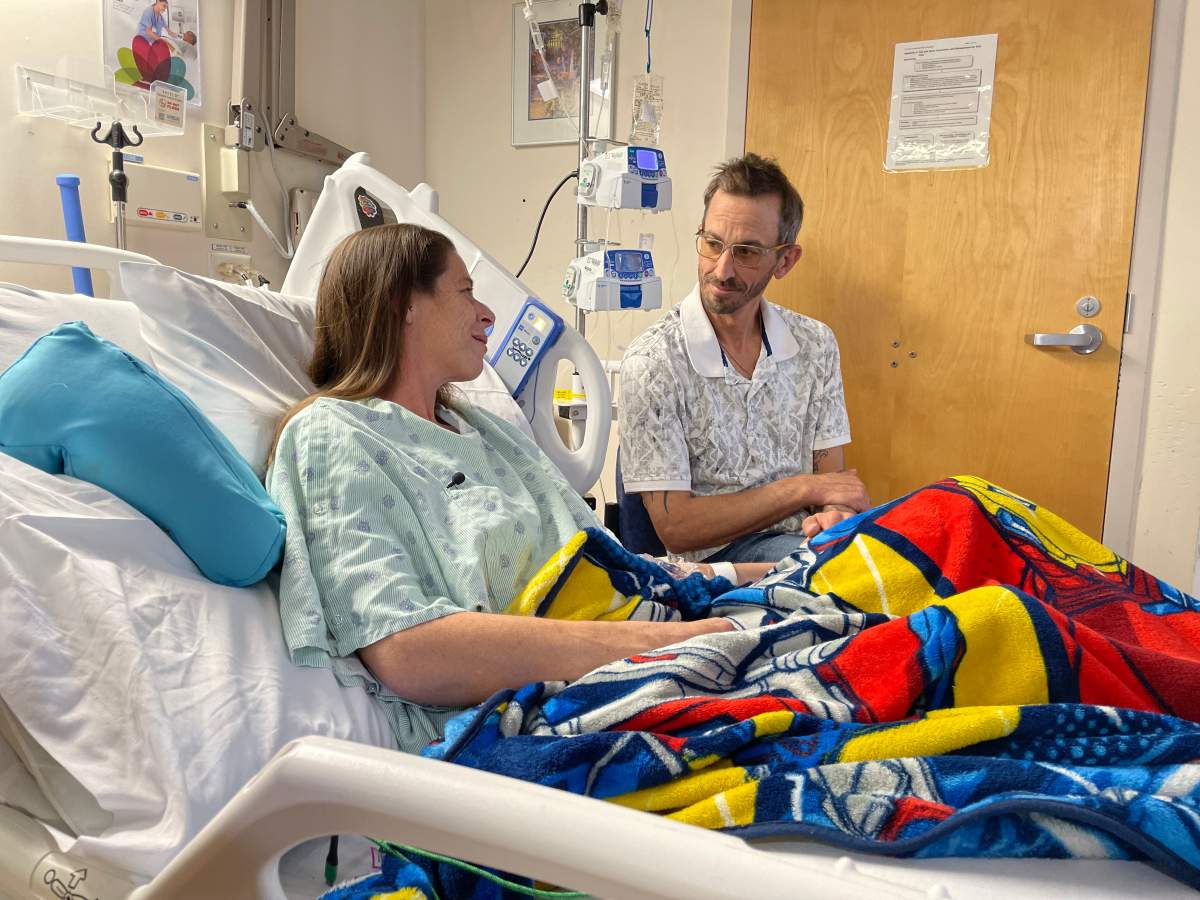Kelly Doucet won’t be forgetting her one-year wedding anniversary anytime soon.

Instead of having a romantic dinner with her husband, Steve, the Yarmouth, N.S., woman was in hospital recovering from painful surgery.
She’s now warning others that symptoms of invasive group A strep should not be ignored.
“If we had waited, Steve would be planning (my) funeral,” Doucet told Global News in an interview from her hospital bed. “So we were so thankful to have an anniversary.”
Doucet said it all began on April 10, when she developed a headache and flu-like symptoms. Her symptoms got worse over the next two days, and progressed to a painful, toonie-sized “hot spot” on the side of her breast.
The spot would turn out to be the beginning of necrotizing fasciitis – also known as flesh-eating disease – which can be caused by invasive group A streptococcus.
Strep A bacteria found on the skin and throat can cause a wide range of diseases in children and adults. Invasive group A strep occurs when the bacteria causes deeper infections, isolated from a normally sterile body site, such as the blood.
Doucet went to the hospital the evening of April 12, after she got a call from her mother who had read a Global News story about a Nova Scotia couple who died within hours of each other after contracting invasive group A strep.
“She called me and she said, you need to go, and you need to go now,” Doucet said.

Get weekly health news
The story, published earlier this month, included an interview with the couple’s daughters, who urged people to seek medical attention if they developed symptoms of the aggressive illness.

Doucet is now crediting them with saving her life, sparing her family from “a lot of despair.”
“If we had waited another 12 hours, I don’t think I would be here,” she said. “I would have died.”
‘It was bad’
After arriving at the hospital, Doucet said she was admitted quickly and had bloodwork, an X-ray and a CT scan done.
After finding high levels of bacteria, she was pumped with antibiotics and rushed into surgery to remove the infected skin, which had grown to about the size of “three full hands.”
“When the surgeon came in, he basically just said … he couldn’t guarantee what I would wake up with. I could be missing an arm, half an arm, I could be missing a whole breast,” she said.
Doucet, who was diagnosed with invasive group A strep after her surgery, is now missing a large portion of skin from her torso.
“It was extremely rough. I couldn’t look at myself, and I still haven’t looked in the mirror,” she said. “My husband looked at me once and cried, and I knew it was bad.”
Nearly two weeks later, the wound care is still “excruciating” and she has a long road to recovery ahead of her, which will include VON home care and plastic surgery.
“The holes won’t heal on their own. They need the plastic surgeries,” she said. “The lymph nodes have been removed from my arm, so I’m going to need a sleeve to keep my arm in proper shape.”
But still, she’s thankful to be alive. Doucet said those who are experiencing invasive group A strep symptoms should seek help immediately.
“Go to outpatients right away. Don’t wait.”
Increase in cases
Cases of invasive group A strep, also known as iGAS, have been on the rise since mid-2022, according to Nova Scotia Health.
“Public Health has been sharing since January that there are a high number of invasive group A streptococcal infections (iGAS) in Nova Scotia, as is being seen across Canada,” NSH spokesperson Brendan Elliott said in a statement.
“Necrotizing fasciitis is one of several possible complications of the severe infection.”
Elliott said necrotizing fasciitis on its own is not a disease that must be reported to public health, “nor is every bacteria that causes this complication, therefore Public Health may not be aware of all cases in the province.
“However, we can confirm there is no outbreak of necrotizing fasciitis or of iGAS anywhere in Nova Scotia,” he said.
So far this year, there have been 39 iGAS cases, and 10 deaths in January and February alone. In 2023, there were 16 cases in January and February, and six deaths during the whole year.
Symptoms of invasive group A strep include:
- High fever (worsening or persistent despite over-the-counter treatment)
- Severe pain, swelling and redness of the affected area
- Dizziness and confusion
- Rapidly spreading rash
- Nausea and/or vomiting
- Severe pain in the arms, legs, neck or back
- Dehydration
- Changes in skin tone and colour.
Toronto-based infectious disease expert Dr. Isaac Bogoch said group A strep is itself very common, and typically results in strep throat or mild skin and soft tissue infections.
But much less common is the invasive form of the disease, which gets deeper inside the tissue and causes “much more significant” illnesses and symptoms, such as necrotizing fasciitis.
While the risk of catching iGAS is very small, he said it’s important to be aware of the risks of the fast-moving illness.
“Sadly, individuals with invasive group A streptococcus get very sick very quickly,” he said.










Comments